Issue number 122
Newsletter Spring 2024
Spring 2024 Newsletter, edited by Cynthia Brown
Welcome to the latest edition of the LAHS Newsletter. Contributions to future editions of the Newsletter are as always welcome at any time. These can be emailed to the Newsletter editor, Cynthia Brown, at newsletter@lahs.org.uk.
LAHS NEWS
LECTURE PROGRAMME FOR 2023 - 24 SEASON
Unless otherwise notified, lectures will be held in the Victorian Art Gallery at Leicester Museum & Art Gallery, New Walk, and start at 7.30 pm. Please use the main entrance to the Museum on New Walk, and arrive in good time to avoid disruption once the lecture has started. Members will be notified nearer the time if pre-booking is necessary.
Thursday 14 March 2024
The Alan and Joan North Memorial Lecture - discovering Rutland Roman villa
Jim Irvine
Farmer and amateur historian
Thursday 21 March 2024
Taking Stock of the Pot: creating and recreating the Glenfield Iron Age cauldrons
John S. Thomas
University of Leicester Archaeological Services
Thursday 18 April 2024
Brewing History and Pubs in Leicester
Laura Hadland
Local historian
Thursday 2 May 2024
Excavations at St. Anne’s Charterhouse in Coventry
Andy McLeish
University of Leicester Archaeological Services
Thursday 23 May
Excavations of a Later Prehistoric Landscape and Iron Age Settlement at Broadnook Garden Village, Wanlip
James R. Harvey and Adam Clapton
University of Leicester Archaeological Services
EMERITUS PROFESSOR PATRICK BOYLAN
We were very sorry to hear of the death in February 2024 at the age of 84 of Patrick Boylan, until recently LAHS President. Patrick was Director of Museums and Art Gallery, Leicester City Council, from 1972 – 1974, and Director of Arts, Museums and Records, Leicestershire County Council, to 1990. He was Professor and Head of the Department of Arts Policy and Management, City University London from 1990 – 2004, when he returned to Leicester on his retirement with the title of Professor Emeritus in Heritage Policy and Management.In 1981 he served as President of the Leicester Literary and Philosophical Society, entitling his Presidential Address ‘Why Museums?’. If you would like to know more about Patrick’s distinguished life and work, there is a biography at 1981. Patrick John Boylan Esq. B Sc FGS FMA MBIM 1981-82. - Leicester Literary and Philosophical Society (leicesterlitandphil.org.uk).
NEWS FROM THE LIBRARY
DISSERTATIONS
Thanks to Elizabeth Tingle, copies of the work of the first three winners of the inaugural LAHS Dissertation Prizes have been deposited in the Library. Available for reference use only.
BA Archaeology: Jonathan WALSH. The clay tobacco pipes of Bradgate House: social dynamics, trade, and consumption patterns in an elite household. (Univ. of Leicester, 2022) [comparative case study: Mountsorrel]
BA History: Lynn MARRIOTT. Local responses to the Reformations – a case study of Melton Mowbray. (Nottingham Trent Univ., 2022)
MA History: Denise GREANY. “We did not go”: domestic sociability in an early 19th century provincial town. ( Univ. of Leicester, 2022 ) [Ann Shackelford, Shuckburgh, Lutterworth]
BOOKS
CHARTERED INSTITUTE FOR ARCHAEOLOGISTS Professional archaeology: a guide for clients. 2023. Donated by the publisher.
POSTLES, D. Spinsters and sisters: the transformation of a female sphere in Leicestershire, 1858 – 1903. Donated by the author.
ROWBOTTOM, J. 100 years of hard work and trade. Aylestone Journeys into the past. Vol. 5, AJ Publications, 2023. Donated by the author. Vols. 1 – 4 have already been listed.
SAPCOTE HERITAGE GROUP Sapcote and the First World War. Heart of Albion, £7.95, 2023. 9781905646395. Donated by the publisher Bob Trubshaw.
STARR, C. Medieval merchant: John Hende of London and Essex. (Essex Soc. for Arch. & Hist. Occasional Papers, New Series, No.6, 2023) Received as part of Exchange arrangement. Author studied at Leicester University. Hende lent Richard II vast sums of money and was a friend of Dick Whittington and Geoffrey Chaucer.
STATHAM, E. Medieval treasures of Leicester: Wygston’s House glass. Text of talk to Stained Glass Museum, 2021.
STATHAM, E. Withcote Chapel and Galyon Hone and associates. Text of talk to Leicester Stained Glass Appreciation Group, 2023.
Both illustrated in colour. Donated by the author.
ZIENTEK, J. 20 vols. All published in 2023 except where indicated. Donated by the author.
Misterton monument book... 2016
Monumental inscriptions in Shawell...2021
Norfolk mediaeval stained glass: 14 & 15 centuries
14 to 16 centuries second selection
13 & 16 centuries third selection
Continental stained glass in Norfolk churches: 15 to 17 centuries
“ “ second selection
Pictorial study of St. Martin’s Leicester Cathedral...
Raphael Brandon an architect & his works: the references
“ “ ‘s church buildings
“ “ the tragic story of a gifted architect & his works
Rev. John Dudley Vicar of Humberstone and Sileby...
St. Barnabas Church New Humberstone: story of some of those whose names appear on the war memorial...First World War
St. Elizabeth’s Church Nether Hall a brief history
St. Mary’s Church Humberstone Festival of Seasons Greetings...
“ “ history and guide to the church bells...
“ “ “ turret clocks...
“ “ history of the organs and church choir...
“ “ churchyard
“ “ story of soldiers, sailors and airmen on Humberstone War Memorials...
Mr. Zientek is an example to all to make research available by publishing, not leaving it ‘hidden’.
PERIODICALS
A selection with particular Leicestershire articles of interest:
British Archaeology Nov/Dec 2023 Festival of Archaeology report includes Ashby-de-la-Zouch and Hallaton
Jan/Feb 2024 Roman plantation at Melton Mowbray, Rutland Roman mosaic (8p.)
Mar/Apr Festival of Archaeology 2024 will be 15-30 July
Derbyshire Archaeological Journal 143 2023 various Leics. references in the index
English Place-Name Society Journal 54 2022 Scandinavian element in Leics. minor names: a study of East Goscote north of the Wreake
Harborough Historian 40 2023 articles on Great Easton, Hallaton, Kibworth. Donated by Market Harborough Historical Society
Hinckley Historian 92 Winter 2023 Burbage street names, and an appeal for relevant articles. Donated by Hinckley Museum
Leics. VCH News 14 2023 reports from Ibstock, Loughborough, Lutterworth, ‘Who was Mary Tate’. The 200 Club needs more members. Donated by the Editor.
Rutland Record 43 2023 trade tokens; Francis Davis, cavalryman; monumental brasses. Donated by the Editor
NEWSLETTERS
Heritage Now 7 Winter 2023 report on the Old Tannery, Hallaton
The Library continues to receive catalogues from Cottage Books which are well worth a look to enhance your own bookshelves.
The Society is grateful, as always, to those individuals and societies kind enough to donate publications to the Library, particularly those for review in the Leicestershire Historian.The Library continues to be on the route of guided tours of the Guildhall for visitors to see the view down into the Great Hall and the ‘back-to-front’ graffiti on the windows.
Aubrey Stevenson, Hon. Librarian.
LAHS DISSERTATION PRIZES 2024
There were no entries for the prizes in BA/BSc Archaeology or MA/MSc Archaeology for 2024, but we were pleased to award the History prizes. The award for best dissertation for BA History has gone to Jakub Milcarz for ‘Living Conditions in Polish Resettlement Camps 1947-1960’ (De Montfort University, 2023). The study looks at living conditions in the Polish Resettlement Camps in post-war Britain, focusing on physical aspects of camp life such as the quality of housing and food, as well as the social and cultural well-being of the camp inhabitants. Using oral histories as well as newspapers, government reports and memoirs this study demonstrates that the living conditions in the camps were inadequate when the Poles arrived but were subsequently improved.
Case studies from a variety of camps from across Britain - but with a majority drawn from Leicestershire and Rutland - demonstrate that the presence of nation-wide Polish institutions such as the ex-combatant's association or the Polish Catholic Mission as well as access to the Polish exile press meant that despite geographical separation, the camps developed across the same cultural trajectory. By understanding the agrarian origin of the Poles, their war time experiences and the subsequent development of the exile identity, we can see how the camps were transformed to suit a traditional Polish way of living as well as creating a unique Polish cultural enclave.
The award for best dissertation for MA History went to Susan Hughes for ‘Merchants and Ministers: the Cradock family, trade and Puritanism in seventeenth century England’ (University of Leicester, 2023). The merchant companies were widely involved in supporting and funding the spread of religious non-conformity in the seventeenth century. This case study, utilising apprentice registers, family wills, family letters and the church court records of the Diocese of Rutland reveals how the Cradock family were involved in the Puritan movement at both the international, national and local level.
Two brothers are examined here, Matthew the successful merchant and first Governor of the Massachusetts Bay Colony, and his brother Samuel, a member of a prominent group of non-conformist clergy in the County of Rutland before and during the Civil War. Emphasis is on the brothers’ commitment to the Puritan movement and on the importance of family, business and religious networks in their success and that of their immediate descendants who were to become influential church leaders and academics in the later Stuart period.
Congratulations to the winners. The prizes will be presented at the Alan and Joan North Memorial Lecture on 14 March 2024. Our grateful thanks also go to LAHS Committee member Professor Elizabeth Tingle for facilitating the awards.
MEMBERS’ BLOGS – A NEW FEATURE ON THE LAHS WEBSITE
The LAHS website now features short pieces on a wide range of topics relating to different aspects of Leicestershire and Rutland’s past. These range from the life of George Hort, a prominent leader of the Leicester Framework Knitters Union; life on Northfields Council Estate in Leicester, constructed in the late 1930s to house people displaced by slum clearance schemes in the city; a fresh look at how far our understanding of late Neolithic/early Bronze Age Leicestershire has come since the discovery of an ancient Beaker burial almost 50 years ago on Smeeton Hill in south Leicestershire; the Siege of Leicester in 1645; and the life and work of a Polish homeopath who lived and worked in Leicester for a short time in the 1860s.
If you have an interest or research project that you would like to share through a blog, or an idea for one to explore further, please contact us at website@lahs.org.uk.
PUBLIC HERITAGE FUND
A LAHS Public Heritage Fund grant has enabled Hallaton Museum to update their Hare Pie Scramble and Bottle Kicking exhibition, fascinating local events which have a long history. Successful crowdfunding by the museum also contributed towards the exhibition refresh. Bottle Kicking, held on Easter Monday, is one of the most famous events held in Leicestershire which has taken place each year since the early 1600’s. Annually it attracts thousands of visitors and has been the subject of various television documentaries. The new display boards greatly enhance the visitor experience, and continue to promote this famous event. See Public Heritage Fund - LAHS for more.
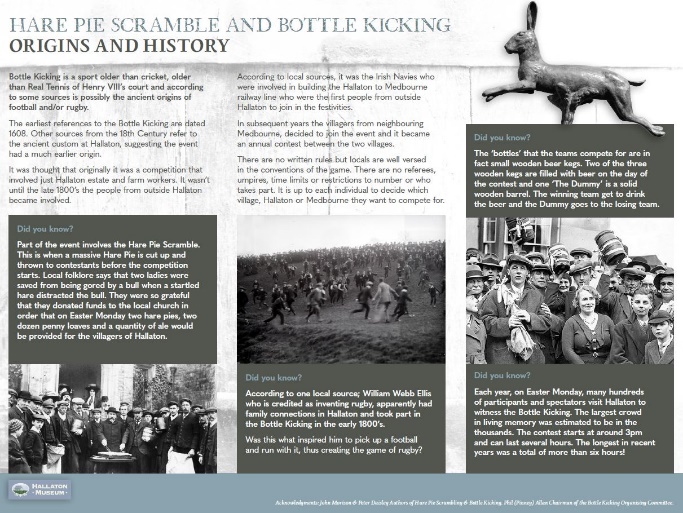
OTHER NEWS
NEWARKE HOUSES MUSEUM, LEICESTER
‘Popping to the Shops’, an exhibition at Newarke Houses Museum, Leicester has been extended due to popular demand, and will now remain on display until Sunday 1 September 2024. The exhibition features the people of the Narborough Road, one of the most ethnically diverse roads in the country, and offers the opportunity to learn more about their experiences and memories. A number of new museum objects have been collected from the shops, and are displayed in the exhibition. A local photographer has worked with the people and museum team to produce the new photographs on display. Cynthia Brown will also be repeating her recent talk on ‘Charnwood Street Shops’ at Newarke Houses on Sunday 16 June 2023. There will be more details of this in due course on the museum website at Whats On – Leicester Museums.
ROBERT HALL MEMORIAL BAPTIST CHURCH, LEICESTER - OPPORTUNITIES FOR VOLUNTEERS ON CHURCH AND COMMUNITY HISTORY PROJECT
From Kevin Brown, Director of this project to mark the 125th anniversary of the church:
Robert Hall Memorial Baptist Church stands proud on the corner of Narborough and Upperton Roads. Built in 1901 alongside many of the local residences, it has long been a significant player in the development of the neighbourhood. A church and community history project has recently been launched focusing on the story of the church in the context of the surrounding community. Several studies are being created including a demographic study 1902-1906 of the original members, an oral history project, and research into archival and newspaper records.
Regular events with expert speakers are under way along with Tea & Cake afternoons for encouraging memory sharing. The project will end in late 2026 with a celebration of the 125 years of church and community and the publication of a historical account which will include the stories of the local people alongside the historical research. Opportunities for volunteering in every aspect of the project are now available offering free training in the necessary skills. Additional volunteering roles include publicity, events, photography, and administration. This is a great way of making new friends and meeting up with old ones. If you are looking to volunteer your time and talents in an exciting local initiative, please get in touch. Contact Kevin on 07913 239769 or lesterlad56@googlemail.com, or drop in at the church hall on Narborough Road on a Thursday afternoon.
ARCHAEOLOGY
UNIVERSITY OF LEICESTER ARCHAEOLOGICAL SERVICES (ULAS)
Dr Gavin Speed reports on recent fieldwork by ULAS:
Over the winter ULAS have been busy on two large excavations, along with several smaller projects. Our team have been hampered by the very wet winter weather, with flooded sites often slowing and/or preventing work. All have done well to work well in the tough conditions. Within Leicestershire, a large excavation at Sileby is expected to conclude early in March. Following earlier archaeological investigations (Desk-Based Assessment, geophysical survey, and trial trench evaluation in February 2023) the site was shown to contain part of an Iron Age settlement. The archaeological excavation begun in Autumn 2023, over an area of almost 2ha, revealing a more complex picture than had previously been expected.
The extensive Iron Age settlement consists of six ditched enclosures, some containing roundhouses, others perhaps utilised for livestock. There is some multi-phased activity to the site, with a drove way, pits and ditches. Finds have included large quantities of pottery, animal bones, and an unusually large number of quern stones (see photo of pit containing these and large pottery sherds). Environmental soil samples have proved productive revealing evidence for grains, chaff and seeds, typical of the Iron Age, across the site.
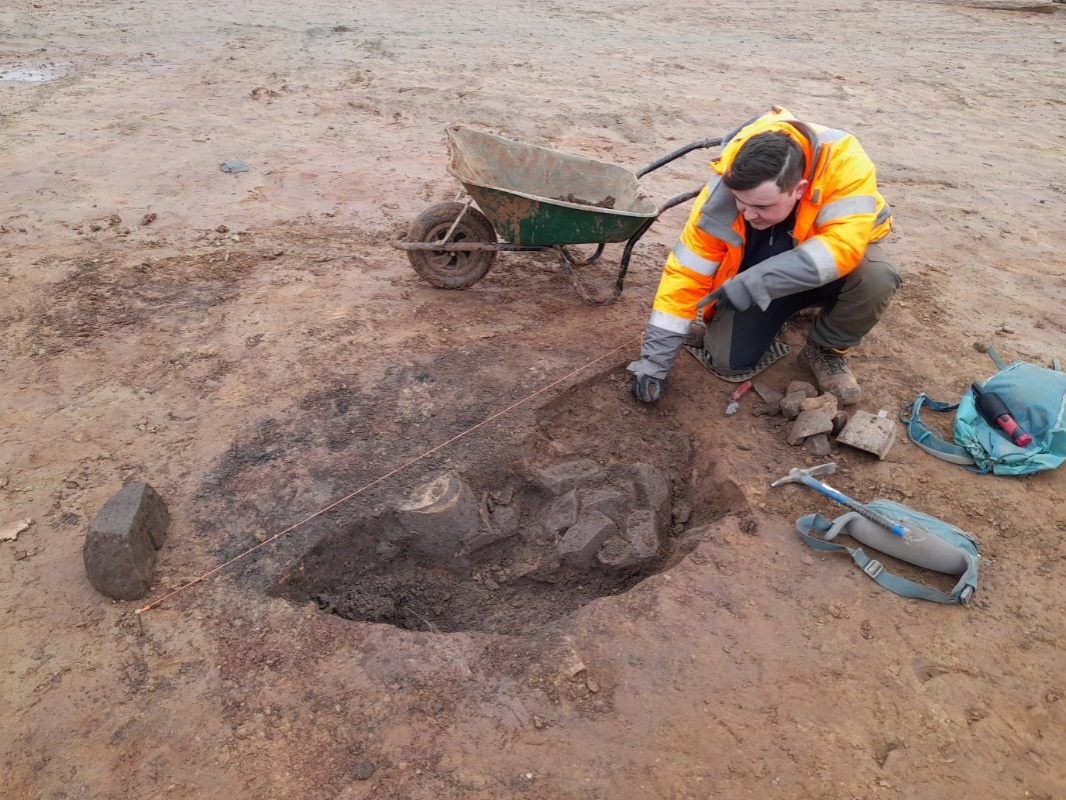
Features of notable interest are coming to light. There is a discrete deposit of hazelnut shell from one roundhouse that hints of earlier prehistoric activity. There is a discrete deposit of chaff, in the basal fill of an enclosure that could indicate focused crop processing activities in the vicinity. Another pit contains large quantities of spelt grain, chaff and weed seeds. The plant remains are helping to better understand and revise interpretations of this feature. Dense deposits of charcoal are also being found, and in a roundhouse, metal working waste has been recovered from bulk samples. The results from the samples are preliminary, but they are promising and will help to better understand the site settlement phasing, diet of the inhabitants, crop processing and agricultural practices.
FORTHCOMING EVENTS
GREATER WIGSTON HISTORICAL SOCIETY
Tuesday 19 March 2024, 7.15 pm
Quorn and Woodhouse: the story of a station
Jack Shaw
Tuesday 16 April 2024, 7.15 pm
Leicester Cathedral Revealed
Mathew Morris
Meetings are held at the Menphys Hub, Bassett Street, South Wigston, LE18 4PE; doors open 6.45 pm. Further information - GWHS Meetings (wigstonhistoricalsociety.co.uk) .
HINCKLEY AND DISTRICT MUSEUM
21 March 2024, 7.30 pm
The Dare Brothers: Hinckley’s Victorian heroes
Hugh Beavin
18 April 2024, 7.30 pm
A Burbage Boyhood
Dennis Perkins
Meetings are held at Hinckley Great Meeting Chapel, Baines Lane, LE10 1PP. Free car parking next to the venue. Visitors welcome; admission £5 at the door. For further information – hinckleymuseum@hotmail.co.uk.
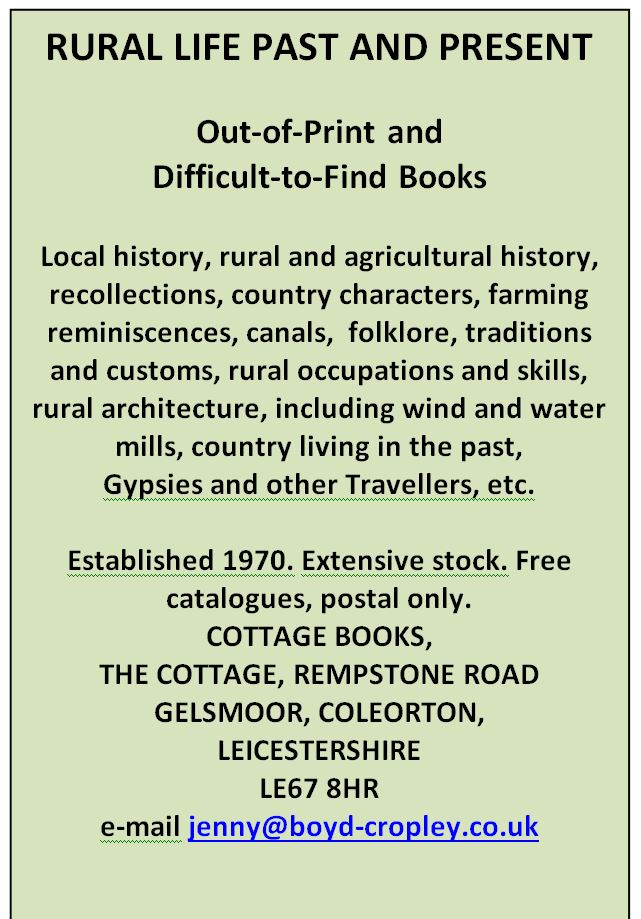
HISTORICAL ASSOCIATION – LEICESTER BRANCH
Tuesday 12 March 2024, 6 – 7.30 pm- online talk
Gone but not Forgotten: ‘Jewish’ property in post-Expulsion England
Dr Dean Irwin
Tuesday 14 May 2024, Clephan0.01, De Montfort University, 6 – 7.30 pm, free entry
Wycliffe, Lollardy and Leicester: origins, significance, and legacy
Dr Rob Lutton
LEICESTER CIVIC SOCIETY
Saturday 23 March 2024, 10.30 – 12 midday
Celebrating Alice Hawkins – a guided tour
Peter Barratt will provide a guided tour of the key places of interest that his suffragette great-grandmother Alice Hawkins frequented during her campaigning years. Starting in front of Alice’s statue on Green Dragon Square (at the rear of the new indoor market building), it will finish at the former Equity Shoe factory on Western Road.
Saturday 6 April 2024, 10.30 am – 12. 30 pm
Wharf Street and Cultural Quarter
Starting from Curve theatre, this walk explores the Cultural Quarter before moving onto the Wharf Street and Lee Circle area. Wharf Street is perhaps a less glamorous part of Leicester, but with some interesting social history! The walk will be led by James Gunn.
Both walks cost £5 for members and £7 for non-members, and advance booking is essential. See All Events - Leicester Civic Society for more details and bookings.
LEICESTER CITY, COUNTY AND RUTLAND AT RISK MEMORIALS PROJECT
Open Day, Saturday 16 March 2024, 11 am – 4 pm
Chancel (rear of) All Saint’s church, Highcross Street, Leicester, LE1 4PH
Entry to the Open Day is free, and volunteers are often on hand to talk about the background to the war memorials on display. For more information and to book in advance, see Open Day - At Risk War Memorials Project.
LEICESTERSHIRE AND RUTLAND FAMILY HISTORY SOCIETY – LEICESTER GROUP
Wednesday, 13 March 2024, 7.30 pm
Living in a box: the story of Leicester’s prefabs
Brian Johnson
Wednesday 10 April 2024, 7.30 pm
Farewell to the land of my childhood: emigration from the UK in the Victorian period
Cynthia Brown
Venue - Oadby Granville Tennis Club, Leicester Road, Oadby, LE2 4AB. There will be a change of venue from May 2024, location to be confirmed. For meetings of LRFHS branches in Hinckley, Loughborough, Market Harborough and Oakham, see LRFHS - Meetings.
LEICESTERSHIRE FIELDWORKERS
Thursday 21 March 2024, 7.30 pm, Rattray Lecture Theatre, University of Leicester
Stepping out from the Dark: An Anglo-Saxon Settlement at Eye Kettleby
Dr Gavin Speed, University of Leicester Archaeological Services
All welcome; free entry. Further details at Talks Programme – Leicestershire Fieldworkers (leicsfieldworkers.org)
MARKET HARBOROUGH HISTORICAL SOCIETY
Wednesday 13 March 2024, 7.30 pm
Abbeys and Priories of Leicestershire
Peter Liddle
The Middle Ages saw the foundation of many religious houses, which were an important aspect of life in mediaeval Leicestershire but were swept away in the 1530s. Peter will talk about these abbeys and priories, what now remains of their buildings and what became of them after the Dissolution.
Wednesday 10 April 2024, 7. 30 pm
The Postwar Polish Resettlement Camp at Husband’s Bosworth
Bozena Kucewicz
Bozena tells the story, often from a personal perspective, of the many Poles displaced during World War II displaced Poles, how they survived the war and ended up stranded, making what they thought were temporary homes in vacated British military camps, one of which was at Husbands Bosworth.
Wednesday 8 May 2024, 7. 30 pm
Landscapes of Punishment in the Countryside: the golden age of the gibbet
Professor Elizabeth Hurren, University of Leicester
Elizabeth has recently been involved in a project to map gibbets in the English countryside – a form of post-mortem punishment reserved for the worst enemies of the 18th and 19th century state. In this talk she will concentrate on Leicestershire and the East Midlands to discuss aspects such as landscape placement, costs, technology and craftsmanship of gibbets as well as popular superstitions.
Meetings are held at the Youth Wing, Market Harborough Methodist Church, Northampton Road, Market Harborough, LE16 9HE. Doors open 7 pm. All are welcome. There is a £1 door charge to help with room hire. Non-members pay an additional £3.
THE NATIONAL ARCHIVES
Great Escapes: remarkable Second World War captives
This major new exhibition at The National Archives in Kew opened in February 2024 and will run until 21 July 2024. The exhibition reveals’ iconic and under-told stories of prisoners of war and civilian internees, from famous escape attempts such as the escape from Stalag Luft III that we know as “the Great Escape”, and British officer Airey Neave’s escape from Colditz Castle dressed as a German soldier, to remarkable stories of individuals seeking escape through art, music and finding love. It offers glimpses of the courage and ingenuity that is possible in desperately hard times.
The exhibition is free and there is no need to book a ticket. Directions to The National Archives can be found at How to find us - The National Archives, and opening times (Tuesday – Sunday at Opening times - The National Archives.
ORAL HISTORY SOCIETY –ORAL HISTORY FESTIVAL 2024
Saturday 6 July 2024, 9.30 am –6 pm British Library, 96 Euston Road, London NW1 2DB
The Festival offers attendees the chance to spend a day exploring a diverse range of ideas within oral history. Everyone will have the opportunity to reflect on their practice, discuss with others and hopefully again new perspectives on oral history that they can apply to their work. We invite groups of two or more people to propose a 60 or 90 minute session that should have participation at its core through reflection and discussion. This call is open to all, whether experienced practitioners or those new to oral history; people working as independent practitioners’ community historians; archive, museum and library professionals; those using oral history in schools; or postgraduate students and academics. If selected to run a session at the festival you and/or your group will be asked to facilitate the session, with mentoring and support as needed from a member of the festival's organising group. For further details about the event and how to submit a proposal, see A4-CfP #2 with logo (ohs.org.uk).
RECENT PUBLICATIONS
CHURCH HISTORY IN LEICESTERSHIRE
Nick Miller
The Book Guild, 2024, 520pp, illus, ISBN 978191666065, £14.99
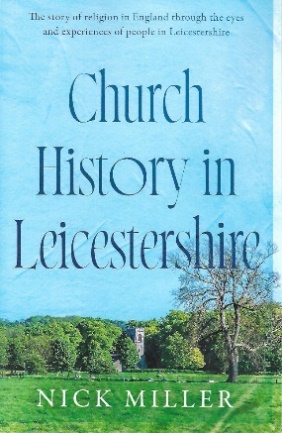
This new publication by LAHS member Nick Miller explores the story of religion in England from pre-Christian times to the 20th century, viewed through the events and eyes and experiences of people in Leicestershire. ‘Why Leicestershire?’, he asks in his introduction, when ‘the cradles of Christianity’ in Roman Britain and its re-emergence in the sixth and seventh centuries lay far away? As well as the relative neglect of church history in the county, the answer lies in ‘ideas, events and players that not only reflected national and international happenings, but… also frequently defined them’ Among them were many individual champions of social justice, as well as ‘epoch-defining moments and movements’ - including the ‘Swinging and not-so-swinging sixties’. As he also notes, many aspects of religion such as architecture and key personalities have been amply covered elsewhere, and he avoids replicating them. Instead, Church History in Leicestershire aims to show how different strands of this history – ideology, religious belief and practice, political and social change, rural and urban life - ‘intertwine’ within the broader historical, geographical, social and political context of their time. The book concludes with a reflection on the future of the church ‘as it faces debates as fundamental as any previously encountered’.
SPINSTERS AND SISTERS: THE TRANSFORMATION OF A FEMALE SPHERE IN LEICESTERSHIRE, 1858 – 1903
Dave Postles
The Author, 2024, 7599, illus (tables and maps)
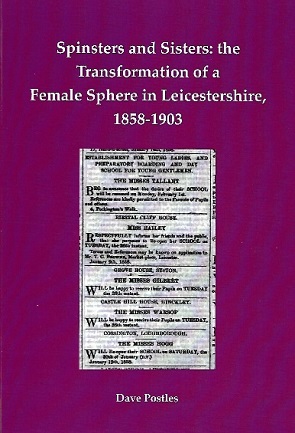
LAHS member Dave Postles assesses the impact of spinsterhood on social and economic developments over this period, along with female household formations (as many spinsters co-habited). His conclusions are based primarily on the National Probate Register (NPR), which commenced in 1858, and the more detailed questions asked by the Census from 1851 which ‘precipitated a “crisis” of concern about unmarried women’. The question of ‘Who were spinsters?’ is a complex one, as he demonstrates by examining different categories of unmarried women, from those with independent means to those living with relatives or employed in a range of occupations including dressmaking, retailing, and industrial work. Life expectancy, voluntary charitable work and the new opportunities offered by local government in the later 19th century are also explored, along with the question of how and why gender relations change, and how significant they are in shaping the lives of men as well as women. The author suggests that the audiences at which the book is aimed– general and academic - may find different aspects of it frustrating: its statistical bases on the one hand or ‘undue repetition of illustrative cases’ on the other. This may be so, but whatever their focus both will gain a strong sense of the nature and implications of the ‘transformation’ heralded in its title. It is also available as a free .pdf from http://www.davelinux.info/OOKS/bookindex.html.
SAPCOTE AND THE FIRST WORLD WAR
Sapcote Heritage Group
Heart of Albion Press, 2023, 60pp, illus, ISBN 9781905646395, £7.95
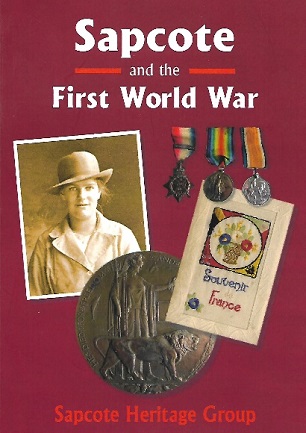
Many men from Sapcote enlisted in the armed forces at the beginning of the First World War in 1914. Others followed over the next four years, and 24 men from the village died in the conflict. This book pays tribute to them as well as illuminating other aspects of the impact of the war on the village. There are brief biographies of all the fallen in a section entitled ‘Remembrance’, the majority of entries accompanied by a photograph. They served not only in the Leicestershire Regiment but the Durham Light Infantry, the Quarrying Company of the Royal Engineers, and others besides, including the Royal Navy. Of those who returned, 82 can be identified by the Absent Voters’ List compiled in advance of the general election of 1918, which is reproduced in the book and provides full names, service numbers and units at that time, alongside a number of photographs.
Another image makes the point about the need for women to take over work previously done by men. This is of Fanny Clarke, two of whose sons served in the military, who joined the Women’s Land Army once it was established in 1917. Extracts from the Log Book of Sapcote village school also make interesting reading, recording for example the departure of the Rector, Rev R. Lound to serve as an army chaplain, and annual fundraising for gifts to soldiers and sailors. The final section shows the local war memorials and the Comrades Wreath, a bronze memorial to the fallen inscribed ‘A TRIBUTE FROM THEIR COMRADES WHO RETURNED’.
* Full reviews of the above publications will appear in the Leicestershire Historian later this year.
IF YOU ARE NOT ALREADY A MEMBER OF LAHS, WHY NOT JOIN?
Membership of LAHS offers a wealth of benefits, including copies of our two annual publications, the Leicestershire Historian and the Transactions of the Society. Members can access our current publications in digital format, and previous publications are available through the Archaeological Data Service. Regular Newsletters and updates on the activities of LAHS are also circulated by email. Very importantly, membership offers a forum for those interested in researching and learning about different aspects of Leicestershire and Rutland's past.
You will also be entitled to vote at our AGM and help shape the future of the Society. Free student membership is available, and carries the same benefits as Individual membership with the exception of copies of the Society's two annual publications and a vote at the AGM. You can join LAHS on our website at Membership application - LAHS by completing an online application, or printing off a paper copy to send to our Hon. LAHS Membership Secretary Gillian Rawlins, c/o LAHS, The Guildhall, Guildhall Lane, Leicester, LE1 5F. If you have any queries please do contact her at membership@lahs.org.uk. If you have received this Newsletter by post and do not have access to the Internet, please write to her instead at the same address. You will be very welcome!
A HISTORICAL FOOTNOTE
Easter was an occasion for all kinds of secular activities in the past as well as observance of a major religious festival, as this extract from the Leicester Journal of 22 April 1870 suggests.
‘EASTER AMUSEMENTS, &c. The lovely weather which prevailed on Easter Monday and Tuesday caused this annual holiday to be kept with great zest by the inhabitants of Leicester. Despite the badness of trade, there was no lack of amusements, and the working classes were thus afforded unusual facilities for enjoying themselves. Special trains were run to London and Birmingham, which were well patronized, while the outlying favourite localities round Leicester had numerous visitors. Bardon Hill, the Monastery, and Bradgate Park were lively with holiday seekers; 'bus, cab, and every kind of vehicle being called into requisition for the purpose of conveying persons. In town, tea meetings, fireworks, and numerous entertainments, were given…
‘We commence- with the Theatre Royal.—Here the indefatigable lessee had provided an ample and attractive bill of fare for his numerous patrons. Besides popular drama each evening, the company, including Mr. and Mrs. Windley, have appeared nightly in a grand spectacular drama, in three acts, entitled “Masaniello, the Fisherman King, and the Dumb Girl of Portici."* Special scenery had been prepared for this piece, and “the eruption of Mount Vesuvius" forms an imposing and terrific tableau...
‘Opening of the East End Recreation Ground.—On Easter Monday afternoon the new recreation ground in the Willow Bridge fields**was formally opened in the presence of a large number of spectators. The proceedings commenced by a procession… headed by the Rifle Band, being formed near the Vestry Hall, Humberstone-gate. A little before three o'clock in the afternoon, they proceeded from that place, along Wharf-street, en route for the ground… The north, south, and west ends of Leicester, have had their playgrounds for some time past, and [Councillor Chambers] was pleased to say that the east of Leicester would now have its playground also… The Corporation for a long time had been making efforts to obtain a recreation ground for them, and he was happy be able to say that they had been successful… he rejoiced to tell them that the ground would in future be open every day except Sunday, for their recreation, until nine o'clock night. (Loud and prolonged cheering.)’.
The entertainment after the official opening included dance music by the Rifle Band, wheelbarrow, donkey and velocipede races, balloon ascents, and ‘fishing for sixpences’, which ‘created far the most general amusement. A large wooden box, about eight inches deep, was placed on the stand, in which was put a quantity of meal and sugar, amidst which twenty sixpences were hidden. A number of youths were brought on to the stand, and their hands tied behind them, and they had to fetch out the sixpences with their mouths. One youth seemed well suited to the task; he swept the meal with his head like a besom, and obtained no less than seven of the sixpences…’. The proceedings concluded with ‘a grand display of fireworks’.
*Originally an opera by Daniel Auber, first performed in Paris in 1828. Masaniello was a fisherman who led the 1647 revolt against the rule of Habsburg Spain in the Kingdom of Naples.
** On the south side of Belgrave Road, not far from Wharf Street itself.
This newsletter is edited by Cynthia Brown and published by Leicestershire Archaeological and Historical Society. Further information about the Society, its publications and other activities can be found on its website at www.lahs.org.uk.


